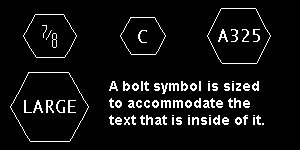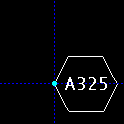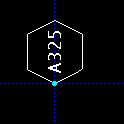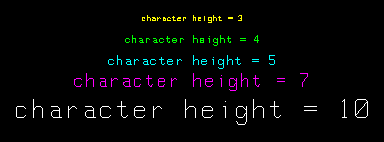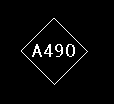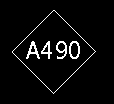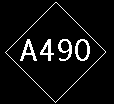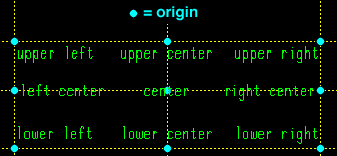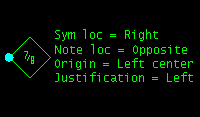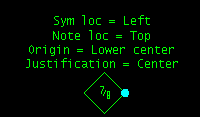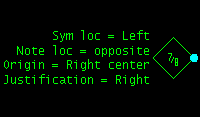The Bolt Symbol Input window ( Drawing Editor )
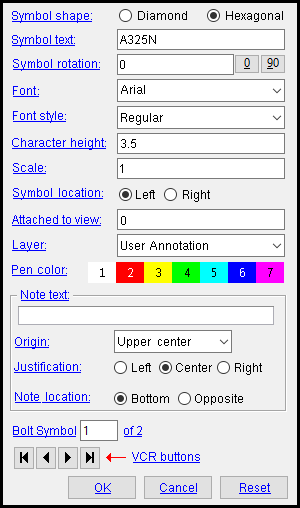
Bolt symbols can be added to any type of drawing in the Drawing Editor using tools such as Objects > Bolt Symbols > Add or Objects > Bolt Symbols > Bolt Sym Combo .
Bolt symbols can also be generated automatically, during auto detailing of erection views, in order to call out non-standard field bolts. To get Detail Erection Views to generate these bolt symbols, the option for "
Non-standard field bolts " must be turned on (checked) and appropriate entries must be made to the Match Table in Nonstandard Field Bolts on Erection View Details ( Home > Project Settings > Fabricator > Non Standard Field Bolts on Evu Details ) and the erection view that is detailed must include members with connections that have non-standard field bolts.
All bolt symbols, whether they have been user added or generated during auto detailing, can be edited on this window.
Also see :
- Bolt Symbols (topic)
- Grayed out fields (indicate mixed entries or that the field is disabled)
- Multi Items Edit (related window)
page 1 | contents | objects > bolt symbols > | objects -- bolt symbols | top
 " Copy " " Paste " " Save " " Load " buttons
" Copy " " Paste " " Save " " Load " buttons
page 1 | contents | objects > bolt symbols > | objects -- bolt symbols | top
------ Settings ------
Symbol shape: ' ![]() Diamond ' or '
Diamond ' or ' ![]() Hexagonal '
Hexagonal '
|
|
'
Diamond ' creates a diamond-shaped bolt symbol. Optional " Symbol text " (shown) is printed inside of the symbol, and " Note text " (not shown) can optionally be printed next to the symbol.
'
Hexagonal ' creates a hexagonal-shaped bolt symbol. " Symbol text " and " Note text " are optional.
Symbol text: Any combination of up to 16 numbers (1, 2, 3, etc.) and/or letters (a, b, c, etc.) and/or special characters (*, ø, /, etc.) Special characters can include any of the Latin 1 characters 0160 to 0255 .
|
Note: The number of characters entered to " Symbol text " is only one option that affects the symbol size." Font " and " Character height " are also relevant. Also, you can set the " Scale " of the symbol.
Symbol rotation: A positive or negative (-) number of degrees from 180 to -180 that sets the rotation of the bolt symbol with respect to its exact point . The location of that exact point is shown with a cyan dot ( o ) when a bolt symbol is selected.
|
|
' 0 ' (zero) degrees orients the symbol horizontally (not rotated).
A ' positive number ' of degrees specifies the amount of counterclockwise rotation from horizontal.
A ' negative (-) number ' of degrees specifies the amount of clockwise rotation from horizontal.
Font: Any font that is listed can be selected. The font is used for the " Symbol text " and " Note text " of the bolt symbol.
|
Shown here are some of the TrueType fonts that you may have available on your computer. With these fonts, what you see in the Drawing Editor is what you will get on the printed drawing. For the ' SDS2 ' font, the printed thickness of the font is set by the " Pen color ." |
Be sure to also choose the " Font style " that you want. If you select the ' SDS2 ' font, be aware that the " Pen color " affects the thickness of the font when it is plotted. The " Character height " sets the font size.
Setup: " Symbols font " and " Symbols font style " (at Home > Project Settings > Fabricator > Detailing > Drawing Presentaton > the " Fonts " tab > ) determine the font and font style that are applied automatically to bolt symbols that are generated during automatic detailing . The " Labels character height " and " Labels width/height ratio " in Drawing Presentation also affect the auto detailing of bolt symbols.
Font style: The style (' Bold ' or ' Bold Italic ' or ' Italic ' or ' Regular ') of the selected bolt symbol " Font ." Different fonts may have different styles available to them.
Available font styles are listed alphabetically in the font style list box , and the first style that is listed for a particular font is the style that is selected by default. You may, instead of using the default, prefer to choose ' Regular ', which is generally the most popular style for a particular font. ' Regular ' is the only choice that is available for the ' SDS2 ' font. To adjust the stroke thickness of the ' SDS2 ' font, you can change the " Pen color ."
Character height: The height ( in millimeters ) of letters/numbers that make up the characters of the " Symbol text " and " Note text ."
|
Font dependencies: This applies to whatever font is selected as the bolt symbol " Font ," regardless of whether that font is a TrueType font or the ' SDS2 ' font.
Scale: The " Scale " entered below, on this window, changes the size of the symbol text but does not change the " Character height " value that is entered here. The " Character height " is even more independent of the " Drawing scale " of this drawing. Assuming that the sheet that this drawing will eventually be placed on has a scale of 1:1 and you do not re-scale the labels and the printer does not adjust the scale, this will be the actual height of characters on the plotted sheet so long as the " Scale " entered below is ' 1 '.
Also see: The " Labels character height " (in Drawing Presentation setup) sets the font size applied automatically to bolt symbols that are generated during automatic detailing . Bolt symbols added using Bolt Sym Add are by default assigned the character height of the last-added or last-edited bolt symbol -- see " OK ." " Labels width/height ratio " is a related option in Drawing Presentation .
Scale: a number less than 1 or 1 or a number greater than 1 .
|
|
|
A number less than 1 reduces the size of the bolt symbol (including any text in the symbol) by a factor equal to the number entered.
1 is the default size of the bolt symbol. The font size on such a symbol is controlled by the " Character height " that is set on this window.
A number greater than 1 increases the size of the bolt symbol (including any text in the symbol) by that factor.
Symbol location: ' ![]() Left ' or '
Left ' or ' ![]() Right ' or '
Right ' or ' ![]() Top ' or '
Top ' or ' ![]() Bottom ' The choice made here positions the symbol to the left, right, top or bottom of its exact point . That exact point is shown as a cyan dot ( o ) when a symbol is selected.
Bottom ' The choice made here positions the symbol to the left, right, top or bottom of its exact point . That exact point is shown as a cyan dot ( o ) when a symbol is selected.
|
|
|
|
Attached to view: A number designating the view that this bolt symbol is attached to. This applies mainly to member details . For instance, a column detail may have a view of face A, face B and face C. It may also have various section views (Section A-A, Section B-B, Section C-C). All graphical objects that are in a particular view are assigned the same number. The only other type of drawing on which you might find multiple views is a submaterial detail .
Assigning the correct number to an object (line, weld symbol, label, etc.), prevents Shorten and Unshorten problems on submaterial details and member details . Automatically detailed submaterial details and member details are the two Drawing Editor drawing types that can have multiple views.
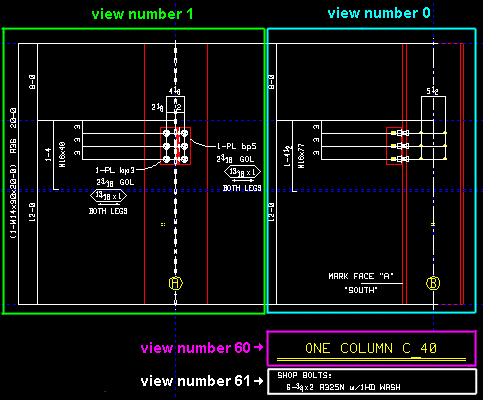
To show a view's number, you can add the X-Y-Z Display to your toolbar. An alternative decoration you can add to display view numbers is the X-Y Dual Show/True Display .

In the Drawing Editor , the X-Y-Z Display shows the view number that the point location target (
) is over.
Troubleshooting: If you Unshorten a drawing then Shorten , only to find that objects are repositioned in a way that seems wrong, the problem might be that the objects are attached to a view that is not the view that they should be attached to. A good troubleshooting method is to select all of the objects that you believe should be attached to the same view, then right-click ( Menu ) and choose " Edit " on the menu . This will open the Multi-Items Edit window. Look at the " Attached to view " field on that window. If that field is gray (shows no view number), then that field has a mixed entry , indicating that objects in your selection have have two or more different view numbers. Entering the desired view number to the " Attached to view " multi-edit field assigns all objects in your selection that one view number.
View number assignment is fairly random. While view numbers assigned during auto detailing are generally the same as the numbers assigned to views in member isolation (or material isolation's edit views mode ), there are cases where that general one-to-one correspondence will not hold. Also, while the main view of a member detail is almost always view 0, the other views are assigned numbers as they are added, and since the order in which views are added is arbitrary, there is little correspondence between a view's number and its type.
How can objects be assigned wrong view numbers? When a user adds an object to a drawing on which there are multiple views (a member detail or a submaterial detail), it is the responsibility of that user to ensure that the object is attached to the correct view. That sounds like an easy thing to do, but it isn't always so simple. Take, for example, a pointer . When a user adds a pointer using Objects > Pointers > Add , the user does not see the Pointer Edit window and therefore does not see the " Attached to view " entry field. Pointers can also be added using Paste , Paste at Original Location , Paste Repeatedly , Paste Special , Paste to Several , Add Standard Detail , Add Standard Detail to Several , Add Weld Combo , Hole Sym Combo , Label Combo , etc. Each of these tools is a different way for users to add a pointer to a wrong view.
Layer: The drawing layer that the bolt symbol you are adding or editing will be drawn on after you press " OK " to close this window. If that layer happens to be hidden (not marked " Show "), the bolt symbol will disappear after the first Redraw .
![]()
Defaults: For a Bolt Sym Add operation, the default selection (
) is the layer that was selected on the Layer Panel before you began the operation. For an Bolt Symbol Edit operation, the default selection is the layer that the Drawing Editor object is currently on.
Pen color: 1 or 2 or 3 or 4 or 5 or 6 or 7 . No button is pressed if you are editing multiple bolt symbols that have different pen numbers.
|
|
| The selected button sets the printing pen number (and on-screen display color) of the bolt symbol. Line Weights sets the thickness of each " Pen color ." |
For a TrueType " Font ," this option affects of that font while you are in the Drawing Editor , but does not, in any way, affect the plotted appearance of the font.
For the ' SDS2 ' Font, the pen color sets the stroke weight (thickness) of the bolt symbol characters. Line Weights assigns a particular thickness to each " Pen color ."
page 1 | contents | objects > bolt symbols > | objects -- bolt symbols | top
------ Note text and related options ------
Note text: Blank or a string of characters .
|
" Note text " is optional. To remove a note, simply delete the " Note text " characters, leaving the field blank. |
Multi-line text: When your cursor is in the " Note text " entry area, the Enter key creates a line break, resulting in multi-line note text.
Special characters can be added as " Note text " using Latin 1 characters 0160 to 0255 . Hold down the Alt key and type in the number using your numerical keypad, or copy and paste from the Character Map that can be launched from your operating system's Accessories menu..
Related settings: The " Font " " Font style " " Character height " and " Scale " applies to the note text as well as to the " Symbol text ."
Origin: Lower left or Left center or Upper left or Lower center or Center or Upper center or Lower right or Right center or Upper right . This applies to " Note text ."
|
This example shows labels, not " Note text ." When a label is selected you can see the origin ( o ) that the label is positioned with respect to. Note text works the same way,. but you have to infer the position of the origin -- you can't see it. |
Example: To orient the note text so that its origin point is at its lower left, select ' Lower left '. To center the note text over the origin point, select ' Center '.
Tip: See the examples for " Note Location ." The choice you make to " Note location " is relevant to the choice you make to " Origin ."
Justification: This applies to multi-line " Note text ."
|
|
|
Note location: ' ![]() Left ' or '
Left ' or ' ![]() Right ' or '
Right ' or ' ![]() Top ' or '
Top ' or ' ![]() Bottom ' or '
Bottom ' or ' ![]() Opposite '. This applies to " Note text ." The choices shown here are not relevant under certain circumstances. For example, notes cannot be placed on the same side as the symbol's exact point ( o ).
Opposite '. This applies to " Note text ." The choices shown here are not relevant under certain circumstances. For example, notes cannot be placed on the same side as the symbol's exact point ( o ).
'
Left ' puts the " Note text " to the left of a diamond-shaped bolt symbol when the " Symbol location " is ' Top ' or ' Bottom '.
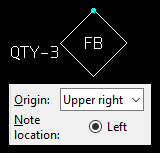
This diamond-shaped bolt symbol is below its exact point ( o ). The note text ( QTY-3 ) is positioned so that its " Note location " is ' Left ' and its " Origin " is ' Upper right '. '
Right ' puts the " Note text " to the right of a diamond-shaped bolt symbol when the " Symbol location " is ' Top ' or ' Bottom '.
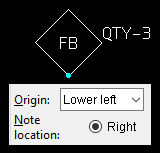
This diamond-shaped bolt symbol is above its exact point ( o ) . The note text ( QTY-3 ) is positioned so that its " Note location " is ' Right ' and its " Origin " is ' Lower left '. '
Top ' puts the " Note text " to the top of a diamond-shaped bolt symbol when the " Symbol location " is ' Left ' or ' Right ' or ' Bottom '.
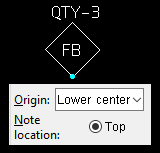
This diamond-shaped bolt symbol is above its exact point ( o ). The note text ( QTY-3 ) is positioned so that its " Note location " is ' Top ' and its " Origin " is ' Lower center '. '
Bottom ' puts the " Note text " to the bottom of a diamond-shaped or hexagonal bolt symbol when the " Symbol location " is ' Left ' or ' Right '.
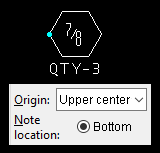
This hexagonal bolt symbol's note text ( QTY-3 ) is positioned so that its " Note location " is ' Bottom ' and its " Origin " is ' Upper center '. '
Opposite ' puts the " Note text " to the side of a diamond-shaped or hexagonal bolt symbol that is opposite to that symbol's exact point ( o ).
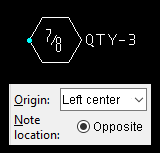
This hexagonal bolt symbol's note text ( QTY-3 ) is positioned so that its " Note location " is ' Opposite ' and its " Origin " is ' Left center '.
page 1 | contents | objects > bolt symbols > | objects -- bolt symbols | top
For when you edit one bolt symbol and multiple bolt symbols are in the drawing :
Bolt Symbol _ of __ (not applicable to Add or multi-edit operations) : The number of the one bolt symbol you are editing and the total count of all bolt symbols in your current drawing. You can use the VCR buttons to select a different bolt symbol and edit that bolt symbol while still on this window. When a bolt symbol on a shown layer is selected, it is displayed in green. The selected bolt symbol must be on a shown layer for it to be shown.
|
|
| VCR buttons (first-previous-next-last) for selecting a bolt symbol to edit. |
Note: If you change one bolt symbol, then select a different bolt symbol number, the first bolt symbol remains changed even if you press " Cancel " on this window.
page 1 | contents | objects > bolt symbols > | objects -- bolt symbols | top
To close the Bolt Symbol Input window :
"OK" (or the Enter key) closes this window window and completes the Bolt Symbol Add or Bolt Symbol Edit or Bolt Symbol Edit (multiple) operation.
Defaults: When you press " OK ," the settings on this window -- except mixed entries -- become the default settings for the next bolt symbol you Add during this session of the Drawing Editor . Even if all you do is double-click a bolt and press " OK " without making any changes on this window, this window's settings become the defaults for the next-added bolt.
Note: After making changes to this window and pressing " OK ," you can still undo your changes by using Revert or Undo . If you Save to make your changes permanent, you can no longer Revert , but you can still Undo .
"Cancel" (or the Esc key or the ![]() button) closes this window without saving any of the changes you have made. In the case where you selected one bolt symbol for editing but changed more than one bolt symbol, " Cancel " only cancels the changes made to the bolt symbol whose number is currently selected as the " Bolt Symbol_ of __ ."
button) closes this window without saving any of the changes you have made. In the case where you selected one bolt symbol for editing but changed more than one bolt symbol, " Cancel " only cancels the changes made to the bolt symbol whose number is currently selected as the " Bolt Symbol_ of __ ."
Defaults: The settings on this window do not become the defaults for new bolt symbols if you press " Cancel " to close this window (unless you used " Bolt Symbol_ of __ ").
Tip 1: If you used " Bolt Symbol_ of __ " to edit more than one bolt symbol, then Undo (after you have closed this window) does undo all those changes.
Tip 2: If you double-click a bolt just to review it and don't want to set the defaults for to-be-added bolt symbols, the best way to close this window is to press " Cancel. "
"Reset" undoes changes made to the bolt symbol currently selected as the " Bolt Symbol_ of __ ." The window remains open.
page 1 | contents | objects > bolt symbols > | objects -- bolt symbols | top


